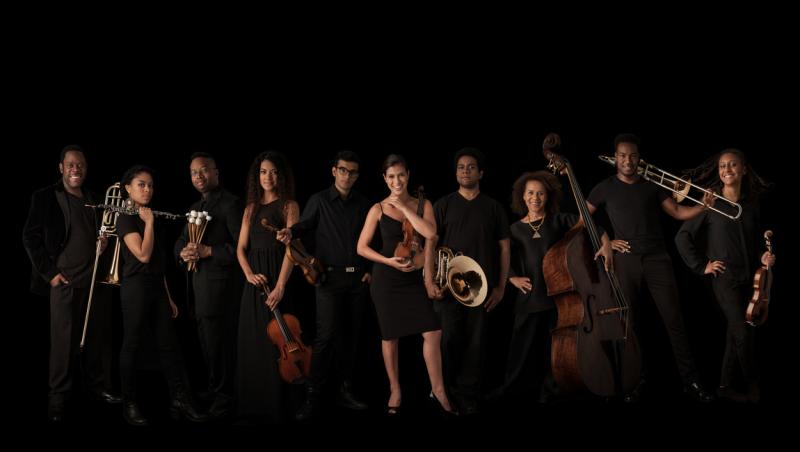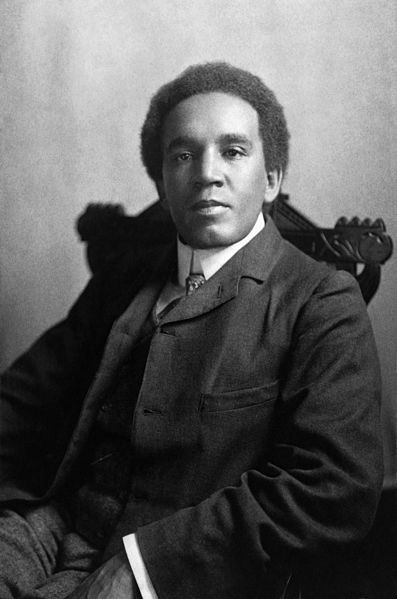Chineke! Ensemble, RNCM, Manchester review - musical advocacy | reviews, news & interviews
Chineke! Ensemble, RNCM, Manchester review - musical advocacy
Chineke! Ensemble, RNCM, Manchester review - musical advocacy
A ground-breaking group in chamber music with a difference

The Chineke! Orchestra has won golden opinions for its ground-breaking work and musical achievement, and Manchester caught up to the extent of a visit from the eight-person Chineke! Ensemble to the Royal Northern College of Music.
There are more points of exposure for a chamber group than might be the case with a larger ensemble, so in some ways the challenge was a big one for Chi-chi Nwanoku and her colleagues. One real plus point was their success in getting an audience that was clearly different from the normal one for chamber music. Its members applauded vigorously after every movement of every work, and sometimes in mid-movement where they thought there was a lull in the music – that’s usually a good sign, meaning people are there who haven’t picked up the inhibitions of the classical in-crowd (and we should remember that until well past the middle of the 19th century it would have been normal practice for the cognoscenti, too).
 Musical advocacy was part of the evening’s purpose. Two movements each selected from Boulogne’s String Quartet in G minor (op. 1, no. 3) and Boccherini’s Cello Sonata in G, performed here by cello and double bass, along with Coleridge-Taylor’s Clarinet Quintet in F sharp minor (op. 10), gave a taste of the little-known, before Beethoven’s Septet in E flat (op. 20). The music by Boulogne (the “black Mozart”) was given by Raja Halder, Didier Osindero, Clifton Harrison and Ashok Klouda in stylishly classical mode, with a neat twist to mark the final reprise of the theme of its rondo movement. Klouda and Nwanoku brought engaging liveliness to their Boccherini, with an impressive cello cadenza in the Largo and an Allegro that bobbed along nicely.
Musical advocacy was part of the evening’s purpose. Two movements each selected from Boulogne’s String Quartet in G minor (op. 1, no. 3) and Boccherini’s Cello Sonata in G, performed here by cello and double bass, along with Coleridge-Taylor’s Clarinet Quintet in F sharp minor (op. 10), gave a taste of the little-known, before Beethoven’s Septet in E flat (op. 20). The music by Boulogne (the “black Mozart”) was given by Raja Halder, Didier Osindero, Clifton Harrison and Ashok Klouda in stylishly classical mode, with a neat twist to mark the final reprise of the theme of its rondo movement. Klouda and Nwanoku brought engaging liveliness to their Boccherini, with an impressive cello cadenza in the Largo and an Allegro that bobbed along nicely.
Coleridge-Taylor’s quintet (the composer pictured above), with Marian Adam its soloist, is an intriguing example of the work of a late 19th century Stanford pupil which bears the Irish pedagogue’s personality very strongly. As a response to the challenge of writing a clarinet quintet unlike Brahms’s, Coleridge-Taylor produced a four-movement work with a slightly modal feel and beautifully presented melodies, sounding at times very like Dvořák. His slow movement’s romantic flavour borders on the sickly-sweet, and his Scherzo offers some almost African rhythmic subtlety, before a finale that springs several surprises. It was all played with vigour and exuberance, but intonation problems crept in here and there, and the Scherzo main theme only came really well together on its repetition.
The Beethoven Septet was a fine example of what the group could do. With Nico Fleury (horn) and Linton Stephens (bassoon) joining Halder, Harrison, Klouda, Nwanoku and Adam, tuning was carefully refined and the playing audibly grew in assurance and fluency. The first movement was neat and buoyant, the Adagio boasted excellent clarinet and horn playing, the minuet jogged along in fine style, and the theme and variations showed off the string players’ abilities. With more attention to tuning, the Scherzo (the “Ludwig” theme for those who remember the TV animation series) and finale kept real rhythmic springs in their steps, in which Chi-chi Nwanoku had a clearly significant role.
rating
Share this article
The future of Arts Journalism
You can stop theartsdesk.com closing!
We urgently need financing to survive. Our fundraising drive has thus far raised £49,000 but we need to reach £100,000 or we will be forced to close. Please contribute here: https://gofund.me/c3f6033d
And if you can forward this information to anyone who might assist, we’d be grateful.

Subscribe to theartsdesk.com
Thank you for continuing to read our work on theartsdesk.com. For unlimited access to every article in its entirety, including our archive of more than 15,000 pieces, we're asking for £5 per month or £40 per year. We feel it's a very good deal, and hope you do too.
To take a subscription now simply click here.
And if you're looking for that extra gift for a friend or family member, why not treat them to a theartsdesk.com gift subscription?
more Classical music
 First Person: clarinettist Oliver Pashley on the new horizons of The Hermes Experiment's latest album
Compositions by members of this unusual quartet feature for the first time
First Person: clarinettist Oliver Pashley on the new horizons of The Hermes Experiment's latest album
Compositions by members of this unusual quartet feature for the first time
 Gesualdo Passione, Les Arts Florissants, Amala Dior Company, Barbican review - inspired collaboration excavates the music's humanity
At times it was like watching an anarchic religious procession
Gesualdo Passione, Les Arts Florissants, Amala Dior Company, Barbican review - inspired collaboration excavates the music's humanity
At times it was like watching an anarchic religious procession
 Classical CDs: Camels, concrete and cabaret
An influential American composer's 90th birthday box, plus British piano concertos and a father-and-son duo
Classical CDs: Camels, concrete and cabaret
An influential American composer's 90th birthday box, plus British piano concertos and a father-and-son duo
 Cockerham, Manchester Camerata, Sheen, Martin Harris Centre, Manchester review - re-enacting the dawn of modernism
Two UK premieres added to three miniatures from a seminal event of January 1914
Cockerham, Manchester Camerata, Sheen, Martin Harris Centre, Manchester review - re-enacting the dawn of modernism
Two UK premieres added to three miniatures from a seminal event of January 1914
 Kempf, Brno Philharmonic, Davies, Bridgewater Hall, Manchester review - European tradition meets American jazz
Bouncing Czechs enjoy their Gershwin and Brubeck alongside Janáček and Dvořák
Kempf, Brno Philharmonic, Davies, Bridgewater Hall, Manchester review - European tradition meets American jazz
Bouncing Czechs enjoy their Gershwin and Brubeck alongside Janáček and Dvořák
 Solomon, OAE, Butt, QEH review - daft Biblical whitewashing with great choruses
Even a top soprano and mezzo can’t make this Handel paean wholly convincing
Solomon, OAE, Butt, QEH review - daft Biblical whitewashing with great choruses
Even a top soprano and mezzo can’t make this Handel paean wholly convincing
 Two-Piano Gala, Kings Place review - shining constellations
London Piano Festival curators and illustrious friends entertain and enlighten
Two-Piano Gala, Kings Place review - shining constellations
London Piano Festival curators and illustrious friends entertain and enlighten
 Echo Vocal Ensemble, Latto, Union Chapel review - eclectic choral programme garlanded with dance
Beautiful singing at the heart of an imaginative and stylistically varied concert
Echo Vocal Ensemble, Latto, Union Chapel review - eclectic choral programme garlanded with dance
Beautiful singing at the heart of an imaginative and stylistically varied concert
 Scott, Irish Baroque Orchestra, Whelan, RIAM, Dublin review - towards a Mozart masterpiece
Characteristic joy and enlightenment from this team, but a valveless horn brings problems
Scott, Irish Baroque Orchestra, Whelan, RIAM, Dublin review - towards a Mozart masterpiece
Characteristic joy and enlightenment from this team, but a valveless horn brings problems
 Classical CDs: Voice flutes, flugelhorns and froth
Baroque sonatas, English orchestral music and an emotionally-charged vocal recital
Classical CDs: Voice flutes, flugelhorns and froth
Baroque sonatas, English orchestral music and an emotionally-charged vocal recital
 Kanneh-Mason, Britten Sinfonia, Shave, Milton Court - a grin and a big beaming smile
A pair of striking contemporary pieces alongside two old favourites
Kanneh-Mason, Britten Sinfonia, Shave, Milton Court - a grin and a big beaming smile
A pair of striking contemporary pieces alongside two old favourites

Add comment